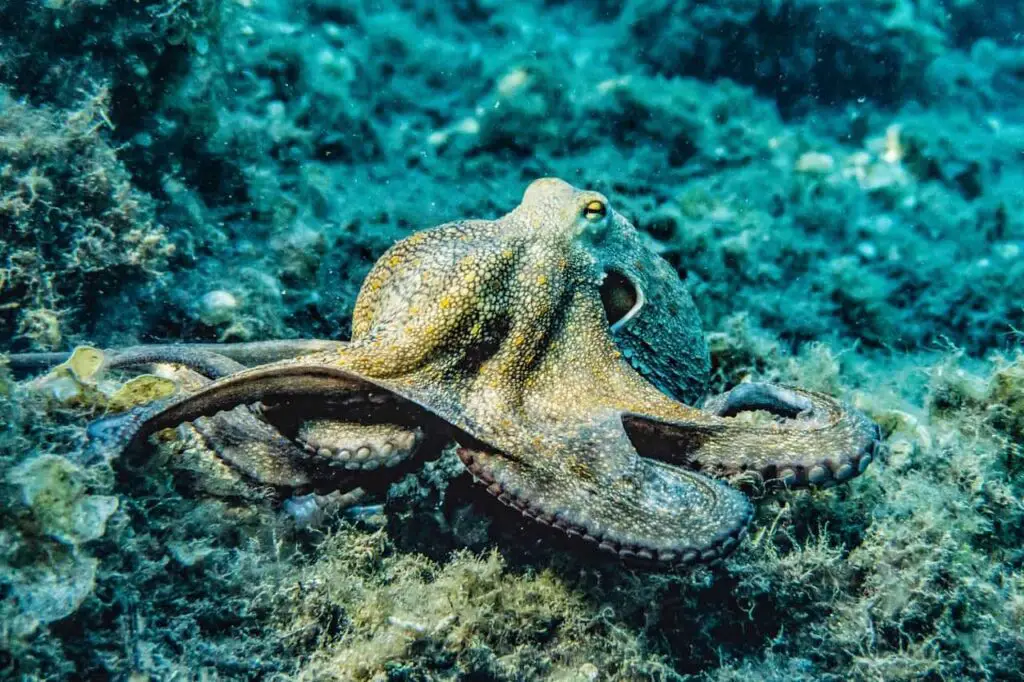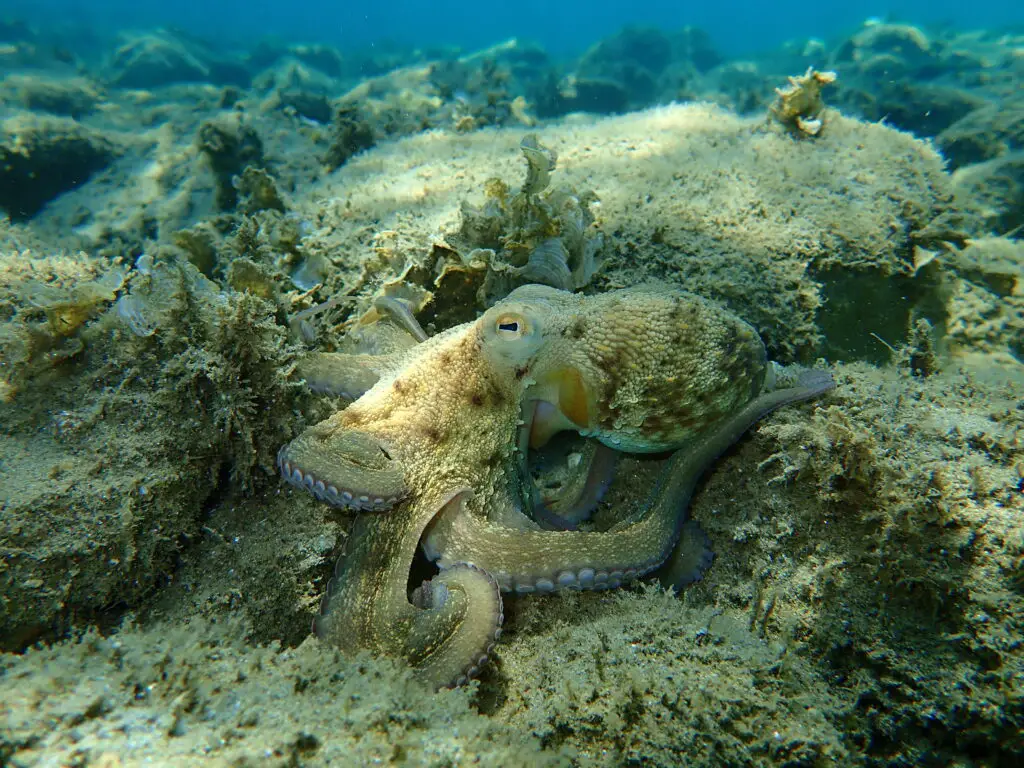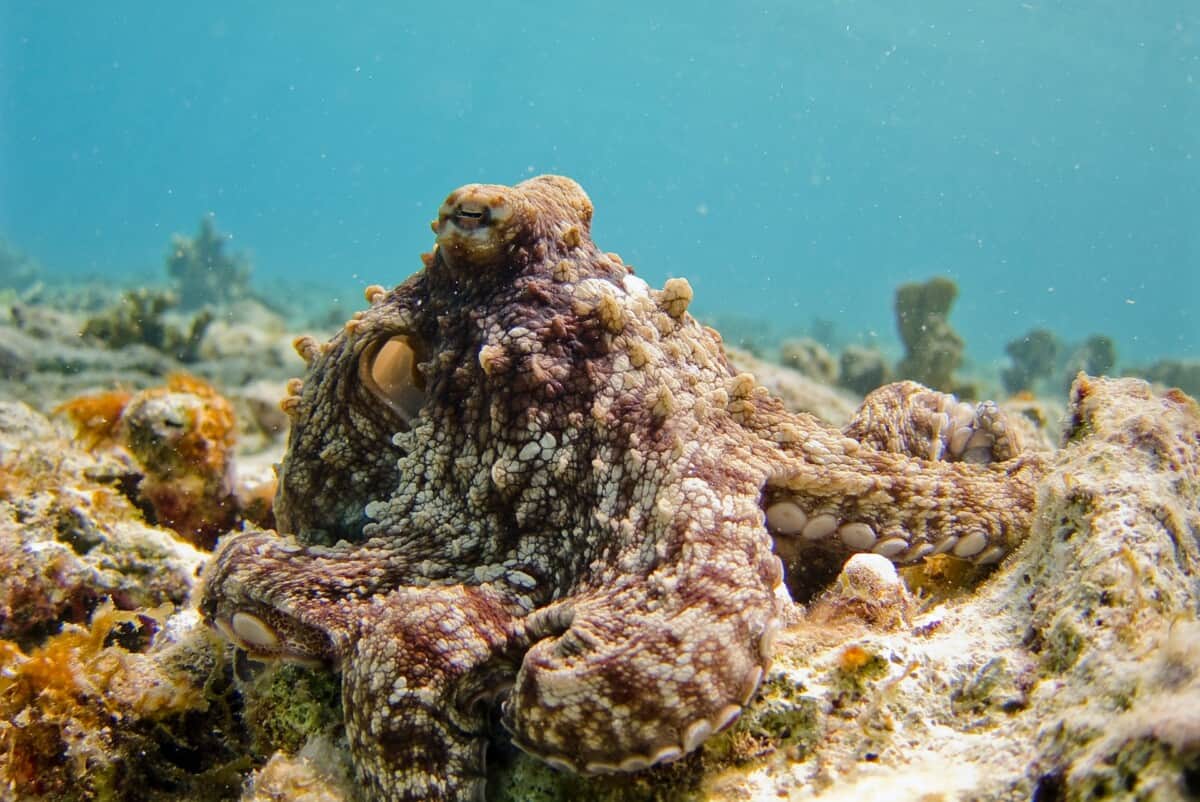Key points about octopus camouflage and their smart skin:
- Octopuses use their skin to change color and texture for camouflage, as well as to detect colors.
- They have specialized cells called chromatophores in their skin that can change color and shape.
- The chromatophores are controlled by muscles and nerves, allowing the octopus to change its appearance in milliseconds.
- Octopuses can also use their skin to mimic the texture of their surroundings.
- They have specialized skin cells called papillae that can raise or lower to create bumps and ridges on their skin.
- By mimicking the texture of rocks or coral, the octopus can blend in with its environment.
How Does Octopus Camouflage Work?
Imagine you’re swimming in the ocean, trying to spot an octopus in its natural habitat. You stare closely at the rocks and coral, but you don’t see anything. Just as you’re about to give up, you suddenly notice an octopus, brilliantly camouflaged, hiding in plain sight.
This incredible ability to blend into their surroundings is one of the many fascinating aspects of octopus camouflage. Their smart skin helps them adapt to a wide range of environments.
You may wonder how octopuses can change their appearance so quickly and accurately.
Thanks to specialized cells these amazing creatures can alter the color, pattern, and even texture of their skin in an instant. As they encounter different surroundings, their smart skin enables them to deceive predators and sneak up on prey with ease.
Watch an Octopus Disappear Before Your Eyes
By observing and learning more about octopus camouflage, scientists have made discoveries that lead to advances in various fields, including materials science and engineering. So the next time you spot an octopus in the wild, take a moment to appreciate the intricate dance of adaptation happening right before your eyes.
Camouflage Mechanisms
In this section, let’s explore the three main mechanisms behind octopus camouflage: chromatophores, iridophores, and papillae.
How Do Chromatophores Change Color?
Your intuition might tell you that octopuses use dyes or pigments to alter their color, but the truth is even more fascinating. Their skin is equipped with specialized cells called chromatophores, which contain sacs of colorful pigment surrounded by muscles. When these muscles contract or expand, different pigments are revealed, allowing the octopus to instantly change its color and pattern.

Imagine you’re an octopus navigating the ocean floor. To avoid detection, you’d control thousands of these chromatophores in sync, effectively making yourself invisible to predators and prey alike. Impressive, isn’t it?
How Do Iridophores Contribute to Octopus Camouflage?
Besides chromatophores, there’s another type of cell responsible for the mesmerizing color changes in an octopus’s skin. Iridophores are cells filled with reflective plates, which create iridescent colors by scattering light. As you might expect, iridophores play a key role in the octopus’s camouflage tactics.
By altering the angle and spacing of the reflective plates, you could control the colors and reflections in your skin—similar to how a prism splits light into a rainbow of colors. Combined with the chromatophores’ pigments, iridophores allow you to mimic not only the colors of your surroundings but also the way light interacts with them.
The Magic of Papillae: True Shape Shifters
Camouflaging your body’s color and pattern would be remarkable on its own, but octopuses go a step beyond this. They can also change their skin texture using muscular structures called papillae. These tiny, finger-like protrusions are controlled by muscles and nerves that can quickly change the octopus’s skin from smooth to spiky or even wrinkled.
Imagine you’re trying to blend in with a rocky seabed. Smooth skin simply wouldn’t cut it, so you’d activate your papillae to create a textured surface that mimics your environment.
This incredible adaptation completes the octopus’s camouflage trifecta, combining color, pattern, and texture for a truly sophisticated defense mechanism.
Nervous System and Skin Control
When you observe an octopus camouflage itself, it’s fascinating to grasp the complexity of their nervous system and skin control. They have the remarkable ability to rapidly change color, pattern, and texture in response to various stimuli.
It’s the intricate coordination between their eyes, nervous system, and skin that makes this possible.
Eyes Are Key to Detecting Background Colors and Patterns

As you marvel at an octopus’s incredible abilities, you might be surprised to learn that their eyes play a crucial role in camouflage. The octopus’s eyes are highly sensitive and capable of detecting even the subtlest changes in their environment. This heightened perception allows them to accurately mimic their surroundings, creating the perfect disguise.
It’s important to note that octopus vision doesn’t function quite like yours, as they see primarily in greyscale. However, this doesn’t obstruct their ability to blend in, as their skin contains light-sensitive proteins called opsins. These opsins are capable of detecting color, which compensates for their monochromatic perception.
Is it True that Octopus Skin Can Detect Colors?
It’s difficult for humans to imagine having skin that can detect colors!
Opsins are specialized light-sensitive proteins that are found in the skin of octopuses and other animals. They play a critical role in vision and color perception, allowing animals to detect and respond to different wavelengths of light.
In octopuses, opsins are particularly important because they help to compensate for their limited color vision. Unlike humans and many other animals, octopuses see primarily in greyscale, with only a limited ability to detect color. However, their skin contains opsins that are capable of detecting color, allowing them to create complex patterns and color changes that are used for both camouflage and communication.
The way that opsins work is actually quite complex. When light hits the skin, it triggers a series of chemical reactions that ultimately result in the activation of the opsins. These activated opsins then send signals to the brain, which interprets the information and creates a perception of color.
What’s interesting about opsins is that they can be tuned to different wavelengths of light, allowing animals to detect specific colors. For example, some opsins are tuned to red light, while others are tuned to blue or green light.
Processing and Reaction Time
Now that you understand the importance of their eyes, let’s dive into the octopus’s processing and reaction time. Their nervous system is highly developed, allowing them to interpret visual information quickly and execute the necessary changes to their skin. Surprisingly, this whole process takes only fractions of a second!
Upon receiving visual input, specialized nerve cells called chromatophores allow the octopus to change color, while other cells enable alterations in skin texture. It’s this efficient communication between their eyes, nervous system, and skin that allows them to react swiftly and camouflage themselves in astounding detail.
In summary, the octopus’s ability to camouflage itself is a result of the remarkable coordination between its nervous system, eyes, and skin. Their highly sensitive eyes, swift processing and reaction time, and the ability to alter skin color and texture all contribute to their incredible camouflage prowess.
As you observe an octopus demonstrating this skill, you can’t help but be captivated by the intelligence and artistry of these fascinating creatures.
Background Matching Techniques

As you dive deeper into the fascinating world of octopus camouflage, you’ll come across a wealth of remarkable techniques that these intelligent creatures employ to blend into their surroundings seamlessly.
In this section, we’ll explore two primary background matching techniques: color matching and texture matching.
Color Matching
One of the most impressive aspects of an octopus’s camouflage abilities is its innate talent to change its skin coloration to match the surroundings. Their skin contains unique cells called chromatophores, which are essentially pigment-containing sacs controlled by the octopus’s muscles and nerves. By contracting or expanding these sacs, they can alter their color appearance at will.
How do they accomplish color matching so effectively, you might wonder?
Octopuses are not color-blind, but their color vision is different from that of humans and many other animals. Octopuses have only one type of color-sensitive cell in their eyes, called a rhabdomeric photoreceptor, which is different from the three types of color-sensitive cells found in the human eye. This means that octopuses are not able to see the full spectrum of colors that humans can see, and they are unable to distinguish between some colors that appear distinct to humans.
However, octopuses are still able to perceive color to some extent, and they are able to use their color vision in combination with other sensory information to create their remarkable camouflage.
Texture Matching
Besides their color-matching prowess, octopuses can also modify their skin’s texture to imitate various underwater surfaces. Special cells called papillae exist just beneath the skin’s surface, and an octopus can control these to adjust its skin texture by muscle contractions or relaxations.
In their quest for visual deception, octopuses display a diverse range of textural possibilities. From the smoothness of sand to the bumpiness of rocks or the jagged edges of coral, these skillful creatures can transform their appearance to blend in with virtually any type of background.
Without a doubt, the octopus’s capacity for background matching through color and texture adaptation is unmatched in the animal kingdom. The next time you observe these extraordinary creatures, take a moment to appreciate their unparalleled mastery of camouflage, made possible by their ‘smart skin.’
Communication and Signaling
As you explore the world of octopus camouflage, it’s important to consider how their smart skin plays a role in communication and signaling. In this section, we’ll delve into how these fascinating creatures use their color-changing abilities for aggression and submission, as well as courtship and mating. It’s truly amazing how such a simple creature can convey complex messages with just a few shifts in hue and pattern.
Aggression and Submission
When it comes to asserting dominance or submitting to a stronger opponent, the octopus has a range of color variations for different scenarios. In situations where aggression is required, you’ll notice an octopus adopt a darker, more vibrant shade. This can be accompanied by changes in body posture, such as raising their arms or elevating their mantle.
On the other hand, when it’s time for submission or evasion, the octopus will typically opt for a more subdued coloration, effectively blending into its surroundings. This tactic of “hiding in plain sight” allows them to escape from potential threats while causing minimal disruption to the environment.
Some key points to remember about aggression and submission in octopuses are:
- Dark, vibrant shades signal aggression
- Subdued colors indicate submission or evasion
- Body posture changes can also convey intent
Courtship and Mating
Octopuses don’t use their color-changing abilities for combat alone; these smart-skinned creatures also rely on visual signals during courtship and mating. By showcasing vivid, pulsating colors, a male octopus can attract the attention of a nearby female.
Once he has succeeded in catching her eye, the male will adopt more subdued tones to indicate a desire for further interaction. It’s important to note that these color changes aren’t solely for show; they also help the octopuses decipher each other’s intentions and avoid potential conflicts.
Here are some important points to remember about courtship and mating:
- Vivid, pulsating colors attract potential mates
- Subdued tones indicate a desire for further interaction
- Color changes help avoid conflict during mating
In conclusion, the adaptive camouflage of the octopus serves as more than just a means of avoiding predators or sneaking up on prey; it’s also a sophisticated communication tool. By exploring the role of smart skin in aggression, submission, courtship, and mating, you can truly appreciate the remarkable ways in which these animals use color to survive and thrive in their underwater world.
Human Technologies Being Modeled after Octopus Adaptations
How can we use these biological adaptations for ourselves?
Well, scientists are already exploring he potential of octopus-inspired materials for a range of applications, from camouflage clothing to soft robotics.
By mimicking the structure and function of octopus skin, researchers have already developed materials that can rapidly change color and texture in response to their environment.
These materials could be used for military applications, such as camouflage uniforms that can adapt to different environments, or for medical applications, such as smart bandages that can change color to indicate infection or inflammation.
References
Hayward, L.E., et al. 2021. “The mechanics of chromatophore distribution in the iridescent skin of cephalopods” This study examines the mechanics of chromatophore distribution in the iridescent skin of cephalopods, including octopuses. The researchers found that the distribution of chromatophores is controlled by a network of muscles and connective tissue, allowing the octopus to rapidly change the color and pattern of its skin.
Kuba, M.J. et al. 2020. “Papillae in cephalopods: Morphology, function, and biomechanics.” This study explores the morphology, function, and biomechanics of papillae in cephalopods, including octopuses. The researchers found that papillae play a key role in camouflage and communication, and that their structure and function are highly specialized for these purposes.
McLennan, A.R.G. et al. 2019. “The role of chromatophores and iridophores in the camouflage and signaling of the common octopus.” This study investigates the role of chromatophores and iridophores in the camouflage and signaling of the common octopus. The researchers found that these specialized skin cells work together to create complex color and pattern changes that allow the octopus to blend in with its surroundings and communicate with other octopuses.


